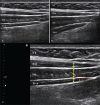Is abdominal hollowing exercise using real-time ultrasound imaging feedback helpful for selective strengthening of the transversus abdominis muscle?: A prospective, randomized, parallel-group, comparative study
- PMID: 29979423
- PMCID: PMC6076057
- DOI: 10.1097/MD.0000000000011369
Is abdominal hollowing exercise using real-time ultrasound imaging feedback helpful for selective strengthening of the transversus abdominis muscle?: A prospective, randomized, parallel-group, comparative study
Abstract
Despite the importance of strengthening of the transversus abdominis (TrA) muscle in individuals with low back pain, the effect of real-time ultrasound imaging on maintenance in selective strengthening of abdominal hallowing exercise (AHE) performance has not been investigated. So, the aim of this study was to investigate the effects of AHE with real-time ultrasound imaging feedback on selective reinforcing the TrA muscle.Twenty healthy subjects were enrolled prospectively and randomized to train AHE for 2 weeks either by conventional feedback (group A) or by visual feedback from real-time ultrasound imaging additional to conventional feedback (group B). The changes in thickness of TrA, internal oblique abdominal muscle (IO), and external oblique abdominal muscle (EO) were measured using the ultrasonography. The changes in muscle activities of TrA-IO and EO were measured using surface electromyography.The thickness of TrA, IO, and EO muscles in resting was not significantly changed in both groups A and B. However, the ratio of root mean square (RMS) values of TrA-IO/EO muscles, which mirrors selective contraction of TRA-IO muscles against EO muscle, was significantly higher in group B than in group A.In healthy subjects, training with AHE using real-time ultrasound imaging feedback may be a useful additional method to conventional feedback for strengthening the TrA muscles selectively.
Conflict of interest statement
The authors have no conflicts of interest to disclose.
Figures




Similar articles
-
Comparison of two different feedback techniques for activating the transversus abdominis: An observational study.J Back Musculoskelet Rehabil. 2022;35(2):357-361. doi: 10.3233/BMR-200299. J Back Musculoskelet Rehabil. 2022. PMID: 34151828 Clinical Trial.
-
Intra-rater reliability of B-mode ultrasound imaging of the abdominal muscles in healthy adolescents during the active straight leg raise test.PM R. 2015 Jan;7(1):53-9. doi: 10.1016/j.pmrj.2014.07.007. Epub 2014 Aug 1. PM R. 2015. PMID: 25088316
-
Abdominal hollowing and lateral abdominal wall muscles' activity in both healthy men & women: An ultrasonic assessment in supine and standing positions.J Bodyw Mov Ther. 2011 Jan;15(1):108-13. doi: 10.1016/j.jbmt.2009.10.004. Epub 2010 Mar 11. J Bodyw Mov Ther. 2011. PMID: 21147426
-
Measuring transversus abdominis activity using pressure biofeedback unit-A technical report.Physiother Res Int. 2023 Oct;28(4):e2033. doi: 10.1002/pri.2033. Epub 2023 Jul 3. Physiother Res Int. 2023. PMID: 37395304 Review.
-
Ultrasound imaging as a feedback tool in the rehabilitation of trunk muscle dysfunction for people with low back pain.J Orthop Sports Phys Ther. 2007 Oct;37(10):627-34. doi: 10.2519/jospt.2007.2555. J Orthop Sports Phys Ther. 2007. PMID: 17970410 Review.
Cited by
-
Ultrasound Imaging as a Visual Biofeedback Tool in Rehabilitation: An Updated Systematic Review.Int J Environ Res Public Health. 2021 Jul 15;18(14):7554. doi: 10.3390/ijerph18147554. Int J Environ Res Public Health. 2021. PMID: 34300002 Free PMC article.
-
Abdominal Hollowing vs. Abdominal Bracing: A Scoping Review of Clinical Trials on Effectiveness for Trunk Stability and Rehabilitation.J Funct Morphol Kinesiol. 2024 Oct 10;9(4):193. doi: 10.3390/jfmk9040193. J Funct Morphol Kinesiol. 2024. PMID: 39449487 Free PMC article.
-
Effects of spinal stabilization exercise with real-time ultrasound imaging biofeedback in individuals with chronic nonspecific low back pain: a pilot study.J Exerc Rehabil. 2020 Jun 30;16(3):293-299. doi: 10.12965/jer.2040380.190. eCollection 2020 Jun. J Exerc Rehabil. 2020. PMID: 32724788 Free PMC article.
-
Numerical modeling of the abdominal wall biomechanics and experimental analysis for model validation.Front Bioeng Biotechnol. 2024 Sep 27;12:1472509. doi: 10.3389/fbioe.2024.1472509. eCollection 2024. Front Bioeng Biotechnol. 2024. PMID: 39398644 Free PMC article. Review.
-
Immediate Effect of Modifying Lumbopelvic Motion During Sitting Knee Extension in People With Low Back Pain: A Repeated-Measures Study.J Chiropr Med. 2021 Sep;20(3):108-114. doi: 10.1016/j.jcm.2021.12.002. Epub 2022 Apr 6. J Chiropr Med. 2021. PMID: 35463845 Free PMC article.
References
-
- Macedo LG, Maher CG, Latimer J, et al. Motor control exercise for persistent, nonspecific low back pain: a systematic review. Phys Ther 2009;89:9–25. - PubMed
-
- Panjabi MM. Clinical spinal instability and low back pain. J Electromyogr Kinesiol 2003;13:371–9. - PubMed
-
- Hides JA, Jull GA, Richardson CA. Long-term effects of specific stabilizing exercises for first-episode low back pain. Spine (Phila Pa 1976) 2001;26:E243–8. - PubMed
-
- Hides J, Gilmore C, Stanton W, et al. Multifidus size and symmetry among chronic LBP and healthy asymptomatic subjects. Man Ther 2008;13:43–9. - PubMed
-
- Hodges PW, Richardson CA. Altered trunk muscle recruitment in people with low back pain with upper limb movement at different speeds. Arch Phys Med Rehabil 1999;80:1005–12. - PubMed
Publication types
MeSH terms
LinkOut - more resources
Full Text Sources
Other Literature Sources

